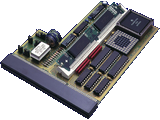
SCSI, IDE and advanced floppy controllers
Most Amiga models have a slow hard disk controller, or even none as standard. Decent SCSI controllers allow using ultra fast hard disks, while IDE controllers allow using cheap drives. Many controllers are combined with memory expansion.

Memory expansions and memory adapters
Basic Amiga configurations have a small amount of memory only. Standalone memory expansions are the cheapest way to support demanding applications.

Graphics cards, scandoublers and deinterlacers
The custom chip sets are perfectly suitable to feed a video equipment or to display graphics on a television but inadequate for displaying high resolution flicker free screens. Graphics cards allow pushing high resolution monitors to their limits while scandoublers allow these monitors to display the native screen modes.

Editing systems, genlocks, time base correctors, digitizers, framebuffers, signal converters, encoders and decoders
A video card makes an Amiga show its real power, many times ending up as the heart of a professional video studio. This duet gives the best price-performance ratio among the other video systems available.

Sound samplers, digital signal processors, decoders
Each Amiga is capable only for 8 bit sound playback and no recording as standard which makes it not too appealing to sound studios. Sound cards remove every limit for the musical virtuosics.

Network controllers
No Amiga has networking capabilities as standard. Ethernet controllers allow linking the Amiga to a network of other platforms, as do expansions that support Arcnet or AppleTalk.

Additional parallel and serial ports, USB and ISDN cards
The built in serial and parallel ports perform somewhat slow compared to today's standards. The extra I/O ports provide better printing and modem performance.

Busboards
Zorro and ISA/PCI busboards allow the installation of expansion cards to small box Amigas or increase the expandability of big box Amigas.

BridgeBoards, emulation support cards
BridgeBoards allow using IBM compatible hardware components in an Amiga. Emulation support cards give the Amiga the extra hardware for the complete software emulation of other platforms.

Arcade Games, Simulators, Medical Systems
With the advanced graphics and video capabilities of the Amiga, it can be the basis for integrated systems for specific purposes. These integrated systems feature an embedded Amiga and custom interface hardware.

Expansions that do not fit the above categories
 Amiga Hardware Database
Amiga Hardware Database
